13 Widgets, Plugins, and Add-Ons to Enhance Your Blog's Performance
With real estate above, below, and to the side of your blog posts themselves, your blog is a lot more than just the content you publish to it. But
with so many different widgets, plugins, and other add-ons out there to
choose from, it can be tough to know what to include and what to leave
out. Choices, choices.
This can leave blog managers in a tizzy, and the result is usually a
blog littered with a ton of unnecessary bells and whistles. An
over-cluttered blog can look messy and unprofessional, and when you have
a lot of widgets and plugins competing for visitors' attention, it can
also dilute the performance of those individual add-ons. And no one
wants that.
So how can you use add-ons to enhance, not inhibit, your blog's
performance? Here's a rundown of the common blog widgets, plugins, and
add-ons you should consider adding to your blog. We'll highlight which
add-ons are must-haves for every blog and provide you with information
so you can prioritize which ones make sense for your blog.
13 Common Add-Ons to Consider for Your Blog
1) Email Subscribe Form (Must-Have)
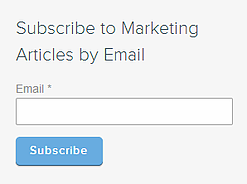 Converting
casual visitors into dedicated email subscribers is a great way to
build up your readership and generate a community of content evangelists
who will go to bat for your content. Not only that, they'll likely
share your content with other people in their networks through email and
social media, exposing you and your blog to brand new audiences.
Converting
casual visitors into dedicated email subscribers is a great way to
build up your readership and generate a community of content evangelists
who will go to bat for your content. Not only that, they'll likely
share your content with other people in their networks through email and
social media, exposing you and your blog to brand new audiences.
But you have to turn those visitors into subscribers in the first
place, which makes an email subscribe form an absolute must-have for any
blog. Make sure you have one in the sidebar (or somewhere else highly
visible) in every article you publish. Considering their utmost
importance, you might also want to consider these other ways to generate more blog subscribers.
2) RSS Feed (Must-Have)
 While
RSS subscribers tend to be a little bit more passive than email
subscribers, there are many people who prefer RSS subscription to email,
and they can be beneficial in the same ways as email subscribers. Make
sure the RSS feed for your blog is also easy to find for visitors who
are looking for it (a good place is right near the email subscribe
form); otherwise, they'll get fed up hunting around for it and bounce
from your site without subscribing at all.
While
RSS subscribers tend to be a little bit more passive than email
subscribers, there are many people who prefer RSS subscription to email,
and they can be beneficial in the same ways as email subscribers. Make
sure the RSS feed for your blog is also easy to find for visitors who
are looking for it (a good place is right near the email subscribe
form); otherwise, they'll get fed up hunting around for it and bounce
from your site without subscribing at all.
3) Author Profiles
Do you have several people contributing content to your blog? Do you
publish content from guest bloggers from time to time? If so, consider
incorporating author profiles into your blog -- both at the end of
individual articles as well as on separate author pages that aggregate content published by that author alone.

Author profiles are a great way to give credit to and promote the
hard work of your contributors, provide readers with information about
who's creating the content they're reading and allow them to connect,
demonstrate the credibility of your writers, and attract additional
guest blogging talent.
4) List of Contributors
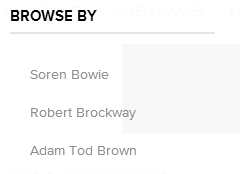 Speaking
of contributors, let's say you have some pretty big names in your
industry who contribute to your blog. That might be something you want
to showcase to new readers in an effort to emphasize the credibility of
your writers. Or maybe you just want to let your readers sort through
your content by their favorite authors.
Speaking
of contributors, let's say you have some pretty big names in your
industry who contribute to your blog. That might be something you want
to showcase to new readers in an effort to emphasize the credibility of
your writers. Or maybe you just want to let your readers sort through
your content by their favorite authors.
If so, consider adding a contributors list to your blog and linking to the author pages of those authors you list, like Cracked does in its top navigation.
5) Social Share Buttons (Must-Have)
Why put all the weight of content promotion on your own shoulders?
Let your readers do some of the legwork for you by providing social
share buttons along with every post you publish. This also gives you the
added benefit of exposing your content not just to those already in
your network, but also to people in your readers' networks.
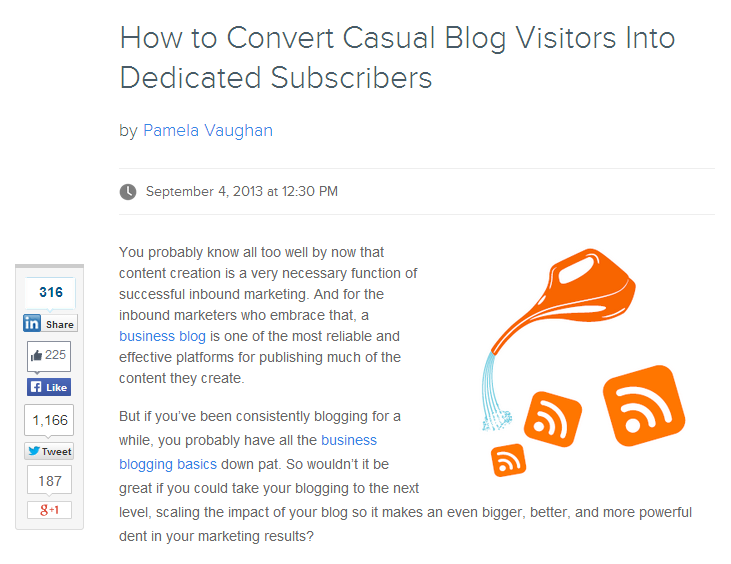
If you can, choose social share buttons that display share counts so you can take advantage of the benefits of social proof.
6) Comments Section (Must-Have)
There's a possibility I may get debated on the "must-have" stamp I
gave this, but I figure you could all discuss it in the comments ;-) I
firmly believe that a blog should encourage a dialogue between the
author and the reader. And while there are definitely downsides to
having a comments section on your blog (e.g. spammers, Negative Nancys, etc.), I think the pros definitely outweigh the cons.
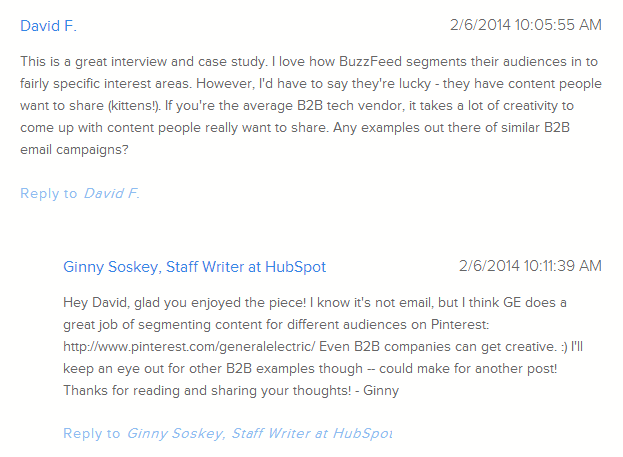
Enabling comments fosters a sense of community among you and your
visitors, makes your blog much more interactive and engaging, allows you
to gather valuable feedback from your readers to inform your content
strategy, and helps you come up with new topics for future blog posts. HubSpot users have a built-in comments engine for blogs hosted on our COS, and other popular comment engines include Disqus and Livefyre.
7) Search Bar (Must-Have)
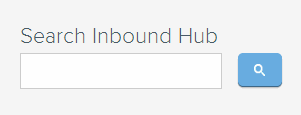 Make
it easy for visitors to find the content they're looking for by adding
search functionality to your blog. This makes for a much better user
experience and encourages your readers to stick around and check out
some of your other content. And if you can implement a search bar that
provides insight into what keywords visitors are searching for on your
blog (e.g. Google Site Search, which integrates with Google Analytics), a
bonus is that you can identify the types of content your readers are
actively searching for and use that to inform your content creation
strategy!
Make
it easy for visitors to find the content they're looking for by adding
search functionality to your blog. This makes for a much better user
experience and encourages your readers to stick around and check out
some of your other content. And if you can implement a search bar that
provides insight into what keywords visitors are searching for on your
blog (e.g. Google Site Search, which integrates with Google Analytics), a
bonus is that you can identify the types of content your readers are
actively searching for and use that to inform your content creation
strategy!
8) Topics/Tags List
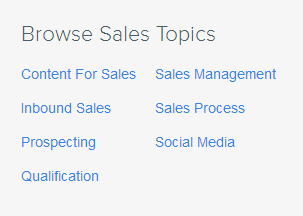 In
addition to a search feature, another good way to help your visitors
discover more of your content is by showcasing a list of your blog's
topics or tags. In addition to giving new visitors an idea of the types
of content you typically write about, a topics list allows readers to
further engage with your content by browsing only the topics that
interest them.
In
addition to a search feature, another good way to help your visitors
discover more of your content is by showcasing a list of your blog's
topics or tags. In addition to giving new visitors an idea of the types
of content you typically write about, a topics list allows readers to
further engage with your content by browsing only the topics that
interest them.
Just make sure you have an actual tagging strategy in place that
organizes your content into logical topic categories rather than
providing readers with a laundry list of tags. In the image above, you
see a list of the topics that categorize the Sales section of this blog -- so readers can dive deeper into just the sales topics they want to read more about.
9) Recent or Popular Post Widgets
 Another
great option for enhancing content discoverability on your blog is to
include recent or popular post widgets, which display a list of either
the latest or most popular posts available on your blog. This allows you
to feature your freshest or best-performing content, enticing visitors
to stick around for more.
Another
great option for enhancing content discoverability on your blog is to
include recent or popular post widgets, which display a list of either
the latest or most popular posts available on your blog. This allows you
to feature your freshest or best-performing content, enticing visitors
to stick around for more.
Most blogging software, including HubSpot's,
offer out-of-the-box widgets that enable you to feature your blog's
most recent or most popular (usually based on most views) posts in your
sidebar. To the right, you can see an example of HubSpot's Post Listing
module in action in our Opinion section.
10) Related Content Plugin
While we're on the topic of content discoverability, this is a good
time to talk about related content plugins. These widgets use algorithms
to recommend other content based on the content a visitor has already
viewed, improving content discoverability and encouraging visitors to
read more articles on your site.
Check out vendors like Outbrain, Zemanta, and Gravity to evaluate related content widgets for your own site. (Above is an example of Outbrain's related content widget on Outbrain's own site.)
To decrease bounce rate, ask them if they can limit the recommended
content only to yours -- not other content from around the web.
11) Calls-to-Action (Must-Have)
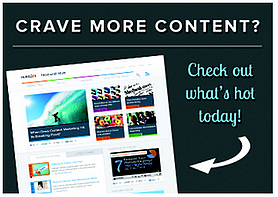 If
you're managing a business blog, chances are you're not publishing
content just for the heck of it. You have other goals in mind. So,
leverage top, side, and/or in-post blog real estate to improve the lead
generation potential of your blog with calls-to-action (CTAs) for your
marketing offers.
If
you're managing a business blog, chances are you're not publishing
content just for the heck of it. You have other goals in mind. So,
leverage top, side, and/or in-post blog real estate to improve the lead
generation potential of your blog with calls-to-action (CTAs) for your
marketing offers.
You can also use CTAs to promote upcoming events, encourage
subscription, or support any of your other marketing goals. The CTA
above, for example, is being used to promote the relatively new design
of our blog homepage, which features new content daily from all five sections of our blog.
12) Social Follow Buttons
 Although
it's a more indirect way of subscribing to your content, following your
company in social media is a form of subscribing in and of itself,
since you're likely already using your social channels to promote your
blog content (right?). Give your visitors the option to follow/connect
with you in social media by displaying social media follow buttons on
your blog as well. This also gives you a way to connect with readers
through multiple channels.
Although
it's a more indirect way of subscribing to your content, following your
company in social media is a form of subscribing in and of itself,
since you're likely already using your social channels to promote your
blog content (right?). Give your visitors the option to follow/connect
with you in social media by displaying social media follow buttons on
your blog as well. This also gives you a way to connect with readers
through multiple channels.
13) Social Plugins
 In
addition to simple social follow buttons, most social networks offer a
variety of different embeddable plugins and widgets you can add to your
blog's sidebar -- or anywhere else on your site for that matter.
In
addition to simple social follow buttons, most social networks offer a
variety of different embeddable plugins and widgets you can add to your
blog's sidebar -- or anywhere else on your site for that matter.
These plugins serve a number of different purposes. They can display
tweets about a certain topic, feature which of the visitors' Facebook
friends are also fans of your brand (e.g. Duct Tape Marketing's sidebar
widget at right), or show which of the visitors' social connections
recommend your content.
These are great if you're trying to increase your social reach and
demonstrate social proof, but don't go crazy installing every plugin and
widget under the sun just because you can. If you're curious about
what's out there, you can check out the social plugins for the most popular social networks here.
What other add-ons would you suggest adding to a business blog? Share your selections in the comments!

 Converting
casual visitors into dedicated email subscribers is a great way to
build up your readership and generate a community of content evangelists
who will go to bat for your content. Not only that, they'll likely
share your content with other people in their networks through email and
social media, exposing you and your blog to brand new audiences.
Converting
casual visitors into dedicated email subscribers is a great way to
build up your readership and generate a community of content evangelists
who will go to bat for your content. Not only that, they'll likely
share your content with other people in their networks through email and
social media, exposing you and your blog to brand new audiences. While
RSS subscribers tend to be a little bit more passive than email
subscribers, there are many people who prefer RSS subscription to email,
and they can be beneficial in the same ways as email subscribers. Make
sure the RSS feed for your blog is also easy to find for visitors who
are looking for it (a good place is right near the email subscribe
form); otherwise, they'll get fed up hunting around for it and bounce
from your site without subscribing at all.
While
RSS subscribers tend to be a little bit more passive than email
subscribers, there are many people who prefer RSS subscription to email,
and they can be beneficial in the same ways as email subscribers. Make
sure the RSS feed for your blog is also easy to find for visitors who
are looking for it (a good place is right near the email subscribe
form); otherwise, they'll get fed up hunting around for it and bounce
from your site without subscribing at all.
 Speaking
of contributors, let's say you have some pretty big names in your
industry who contribute to your blog. That might be something you want
to showcase to new readers in an effort to emphasize the credibility of
your writers. Or maybe you just want to let your readers sort through
your content by their favorite authors.
Speaking
of contributors, let's say you have some pretty big names in your
industry who contribute to your blog. That might be something you want
to showcase to new readers in an effort to emphasize the credibility of
your writers. Or maybe you just want to let your readers sort through
your content by their favorite authors.

 Make
it easy for visitors to find the content they're looking for by adding
search functionality to your blog. This makes for a much better user
experience and encourages your readers to stick around and check out
some of your other content. And if you can implement a search bar that
provides insight into what keywords visitors are searching for on your
blog (e.g. Google Site Search, which integrates with Google Analytics), a
bonus is that you can identify the types of content your readers are
actively searching for and use that to inform your content creation
strategy!
Make
it easy for visitors to find the content they're looking for by adding
search functionality to your blog. This makes for a much better user
experience and encourages your readers to stick around and check out
some of your other content. And if you can implement a search bar that
provides insight into what keywords visitors are searching for on your
blog (e.g. Google Site Search, which integrates with Google Analytics), a
bonus is that you can identify the types of content your readers are
actively searching for and use that to inform your content creation
strategy! In
addition to a search feature, another good way to help your visitors
discover more of your content is by showcasing a list of your blog's
topics or tags. In addition to giving new visitors an idea of the types
of content you typically write about, a topics list allows readers to
further engage with your content by browsing only the topics that
interest them.
In
addition to a search feature, another good way to help your visitors
discover more of your content is by showcasing a list of your blog's
topics or tags. In addition to giving new visitors an idea of the types
of content you typically write about, a topics list allows readers to
further engage with your content by browsing only the topics that
interest them. Another
great option for enhancing content discoverability on your blog is to
include recent or popular post widgets, which display a list of either
the latest or most popular posts available on your blog. This allows you
to feature your freshest or best-performing content, enticing visitors
to stick around for more.
Another
great option for enhancing content discoverability on your blog is to
include recent or popular post widgets, which display a list of either
the latest or most popular posts available on your blog. This allows you
to feature your freshest or best-performing content, enticing visitors
to stick around for more. If
you're managing a business blog, chances are you're not publishing
content just for the heck of it. You have other goals in mind. So,
leverage top, side, and/or in-post blog real estate to improve the lead
generation potential of your blog with calls-to-action (CTAs) for your
marketing offers.
If
you're managing a business blog, chances are you're not publishing
content just for the heck of it. You have other goals in mind. So,
leverage top, side, and/or in-post blog real estate to improve the lead
generation potential of your blog with calls-to-action (CTAs) for your
marketing offers. Although
it's a more indirect way of subscribing to your content, following your
company in social media is a form of subscribing in and of itself,
since you're likely already using your social channels to promote your
blog content (right?). Give your visitors the option to follow/connect
with you in social media by displaying social media follow buttons on
your blog as well. This also gives you a way to connect with readers
through multiple channels.
Although
it's a more indirect way of subscribing to your content, following your
company in social media is a form of subscribing in and of itself,
since you're likely already using your social channels to promote your
blog content (right?). Give your visitors the option to follow/connect
with you in social media by displaying social media follow buttons on
your blog as well. This also gives you a way to connect with readers
through multiple channels. In
addition to simple social follow buttons, most social networks offer a
variety of different embeddable plugins and widgets you can add to your
blog's sidebar -- or anywhere else on your site for that matter.
In
addition to simple social follow buttons, most social networks offer a
variety of different embeddable plugins and widgets you can add to your
blog's sidebar -- or anywhere else on your site for that matter.
No comments:
Post a Comment